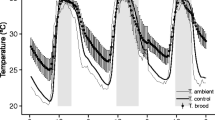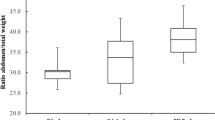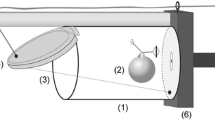Abstract
The courtship acoustics of five species of parasitoid wasps (Hymenoptera: Braconidae), potential candidates for augmentative biological control of Anastrepha (Schiner) species (Diptera: Tephritidae), were compared between recently colonized individuals and those continuously reared 70–148 generations. During courtship, males of these parasitoid species fan their wings and produce a series of low amplitude pulses. The first series of 15 or more continuous courtship pulses was used to measure the pulse duration, frequency, and interpulse interval (IPI) from the beginning, middle, and end of the pulse series. Each parameter was compared between young and old colonies, and among species. Several differences in courtship acoustics were detected in colonies that had been continuously reared. The pulse duration at the end of the pulse series was longer in old colonies for Doryctobracon crawfordi (Viereck) (Hymenoptera: Braconidae), but shorter for old colonies of Diachasmimorpha longicaudata (Ashmead) (Hymenoptera: Braconidae). The IPI of the middle pulse was shorter in old colonies of Opius hirtus (Fischer) (Hymenoptera: Braconidae), and was also shorter at the last pulse for old colonies of both Utetes anastrephae (Viereck) (Hymenoptera: Braconidae) and D. longicaudata. The duration of the middle pulse distinguished the three native species, and separated the two introduced species from each other. We discuss our findings in light of their biological and applied implications, particularly those dealing with quality control of mass-reared parasitoids.


Similar content being viewed by others
References
Aluja M (1994) Bionomics and management of Anastrepha. Annu Rev Entomol 39:155–178
Aluja M, Mangan RL (2008) Fruit fly (Diptera: Tephritidae) host status determination: critical conceptual, methodological, and regulatory considerations. Annu Rev Entomol 53:473–502
Aluja M, Celedonio-Hurtado H, Liedo P, Cabrera M, Castillo F, Guillén J, Rios E (1996) Seasonal population fluctuations and ecological implications for management of Anastrepha fruit flies (Diptera: Tephritidae) in commercial mango orchards in Southern Mexico. J Econ Entomol 89:654–667
Aluja M, Montoya P, Cancino J, Guillén L, Ramírez-Romero R (2008) Moscas de la Fruta, Anastrepha spp. (Diptera: Tephritidae). In: Arredondo Bernal H, Rodríguez del Bosque L (eds) Casos de Control Biológico en México. Mundi Prensa, Mexico City, Mexico, pp 193–222
Aluja M, Sivinski J, Ovruski SM, Guillén L, López M, Cancino J, Torres-Anaya A, Gallegos-Chan G, Ruiz L (2009) Colonization and domestication of seven species of native new world hymenopterous larval-prepupal and pupal fruit fly (Diptera: Tephritidae) parasitoids. Biocontrol Sci Technol 19:49–79
Beukeboom LW, van den Assem J (2001) Courtship and mating behavior of interspecific Nasonia hybrids (Hymenoptera: Pteromalidae): a grandfather effect. Behav Genet 31:167–177
Birke A, Aluja M, Greany P, Bigurra E, Pérez-Staples D, McDonald R (2006) Long aculeus of Anastrepha ludens renders gibberellic acid ineffective as an agent to reduce ‘Ruby Red’ grapefruit susceptibility to the attack of this pestiferous fruit fly in commercial citrus orchards. J Econ Entomol 99:1184–1193
Bloem S, Carpenter JE, Bloem KA, Tomlin L, Taggart S (2004) Effect of rearing strategy and gamma radiation on field competitiveness of mass-reared codling moths (Lepidoptera: Tortricidae). J Econ Entomol 97:1891–1898
Bloem S, Carpenter JE, Dorn S (2006) Mobility of mass-reared diapaused and nondiapaused Cydia pomonella (Lepidoptera: Tortricidae): effect of different constant temperatures and lengths of cold storage. J Econ Entomol 99:707–713
Briceño RD, Eberhard WG, Vilardi JC, Liedo P, Shelly TE (2002) Variation in the intermittent buzzing songs of male medflies (Diptera: Tephritidae) associated with geography, mass-rearing, and courtship success. Fla Entomol 85:32–40
Cayol JP (2000) Changes in sexual behavior and life history traits of Tephritidae species caused by mass-reared processes. In: Aluja M, Norrbom A (eds) Fruit flies (Diptera: Tephritidae): phylogeny and evolution of behavior. CRC, Boca Raton, FL, pp 843–860
Cocroft RB, DeLuca P (2006) Size–frequency relationships in insect vibratory signals. In: Drosopoulos S, Claridge MF (eds) Insect sounds and communication: Physiology, behavior, ecology and evolution. CRC, New York, pp 99–110
Elias DO, Mason AC, Hoy RR (2004) The effect of substrate on the efficacy of seismic courtship signal transmission in the jumping spider Habronattus dossenus (Araneae: Salticidae). J Exp Biol 207:4105–4110
Evenden ML, Spohn BG, Moore AJ, Preziosi RF, Haynes KF (2002) Inheritance and evolution of male response to sex pheromone in Trichoplusia ni (Lepidoptera: Noctuidae). Chemoecology 12:53–59
Field SA, Keller MA (1993) Courtship and intersexual signaling in the parasitic wasp Cotesia rubecula (Hymenoptera: Braconidae). J Insect Behav 6:737–750
Fischer S, Samietz J, Dorn S (2003) Efficiency of vibrational sounding in parasitoid host location depends on substrate density. J Comp Physiol A 189:723–730
Gandolfi M, Mattiacci L, Dorn S (2003) Mechanisms of behavioral alterations of parasitoids reared in artificial systems. J Chem Ecol 29:1871–1887
García-Medel D, Sivinski J, Díaz-Fleischer F, Ramirez-Romero R, Aluja M (2007) Foraging behavior of six fruit fly parasitoids (Hymenoptera: Braconidae) released as single- or multiple-species cohorts in field cages: Influence of fruit location and host density. Biol Control 43:12–22
Geden CJ, Smith L, Long SJ, Rutz DA (1992) Rapid deterioration of searching behavior, host destruction, and fecundity of the parasitoid Muscidifurax raptor (Hymenoptera: Pteromalidae) in culture. Ann Entomol Soc Am 85:179–187
Greenfield MD (2002) Signalers and receivers: mechanisms and evolution of arthropod communication. Oxford University Press, New York
Hernandez-Ortiz V, Perez-Alonso R, Wharton RA (1994) Native parasitoids associated with the genus Anastrepha (Diptera: Tephritidae) in Los Tuxtlas, Veracruz, Mexico. Entomophaga 39:171–178
Huettel MD (1976) Monitoring the quality of laboratory-reared insects: a biological and behavioral perspective. Environ Entomol 5:807–814
Joyce AL, Hunt RE, Bernal JS, Vinson SB (2008) Substrate influences mating success and transmission of courtship vibrations for the parasitoid Cotesia marginiventris. Entomol Exp Appl 127:39–47
Kölliker-Ott UM, Bigler F, Hoffmann AA (2003) Does mass rearing of field collected Trichogramma brassicae wasps influence acceptance of European corn borer eggs? Entomol Exp Appl 109:197–203
Krafsur ES (1999) Sterile insect technique for suppressing and eradicating insect population: 55 years and counting. J Agric Entomol 15:303–317
Kroder S, Samietz J, Schneider D, Dorn S (2006) Adjustment of vibratory signals to ambient temperature in a host-searching parasitoid. Physiol Entomol 32:105–112
Leonard SH, Ringo JM (1978) Analysis of male courtship patterns and mating behavior of Brachymeria intermedia. Ann Entomol Soc Am 71:817–826
Lopez M, Aluja M, Sivinski J (1999) Hymenopterous larval-pupal and pupal parasitoids of Anastrepha flies (Diptera: Tephritidae) in Mexico. Biol Control 15:119–129
Miklas N, Stritih N, Čokl A, Virant-Doberlet M (2001) The influence of substrate on male responsiveness to the female calling song in Nezara viridula. J Insect Behav 14:313–332
Montoya P, Cancino J (2004) El control biológico por aumento en moscas de la fruta. Folia Entomol Mex 43:257–270
Montoya P, Liedo P, Benrey B, Cancino J, Barrera JF, Sivinski J, Aluja M (2000) Biological control of Anastrepha spp. (Diptera: Tephritidae) in mango orchards through augmentative releases of Diachasmimorpha longicaudata (Ashmead) (Hymenoptera: Braconidae). Biol Control 18:216–224
Olson DM, Andow DA (2002) Inheritance of an oviposition behavior by an egg parasitoid. Heredity 88:437–443
Ovruski S, Aluja M, Sivinski J, Wharton R (2000) Hymenopteran parasitoids on fruit-infesting Tephritidae (Diptera) in Latin America and the southern United States: diversity, distribution, taxonomic status and their use in fruit fly biological control. Integr Pest Manag Rev 5:81–107
Reyes J, Santiago G, Hernández P (2000) The Mexican fruit fly eradication programme. In: Tan KH (ed) Area-wide control of fruit flies and other insect pests. Penerbit Universiti Sains Malaysia, Penang, Malaysia, pp 377–380
Richerson JV, Cameron EA (1974) Differences in pheromone release and sexual behavior between laboratory-reared and wild gypsy moth adults. Environ Entomol 3:475–481
Riherd C (1993) Citrus production areas maintained free of Caribbean fruit fly for export certification. In: Aluja M, Liedo P (eds) Fruit flies: biology and management. Springer, New York, pp 407–413
Rull J, Brunel O, Mendez ME (2005) Mass rearing history negatively affects mating success of male Anastrepha ludens (Diptera: Tephritidae) reared for sterile insect technique programs. J Econ Entomol 98:1510–1516
Seeley TD, Reich AM, Tautz J (2005) Does plastic comb foundation hinder waggle dance communication? Apidologia 36:513–521
Sgrò CM, Partridge L (2000) Evolutionary responses of the life history of wild-caught Drosophila melanogaster to two standard methods of laboratory culture. Am Nat 156:341–353
Shuker DM, Phillimore AJ, Burton-Chellew MN, Hodge SE, West SA (2007) The quantitative genetic basis of polyandry in the parasitoid, Nasonia vitripennis. Heredity 98:69–73
Sivinski J (1996) The past and potential of biological control of fruit flies. In: McPheron BA, Steck GJ (eds) Fruit fly pests. A world assessment of their biology and management. St Lucie Press, DelRay Beach, pp 369–375
Sivinski J, Petersson L (1997) Mating in insect swarms. In: Choe J, Crespi B (eds) Mating systems in insects and arachnids. Cambridge University Press, Cambridge, pp 294–305
Sivinski J, Webb JC (1989) Acoustic signals produced during courtship in Diachasmimorpha (=Biosteres) longicaudata (Hymenoptera: Braconidae) and other Braconidae. Ann Entomol Soc Am 82:116–120
Sivinski J, Calkins CO, Webb JC (1989) Comparison of acoustic courtship signals in wild and laboratory reared Mediterranean fruit fly Ceratitis capitata. Fla Entomol 72:212–214
SPSS (2001) SPSS syntax reference guide. SPSS Inc, Chicago
Thomas DB, Worley JN, Mangan RL, Vlasik RA, Davidson JL (1999) Mexican fruit fly population suppression with the sterile insect technique. Subtrop Plant Sci 51:61–71
van den Assem J, Putters FA (1980) Patterns of sound produced by courting chalcidoid males and its biological significance. Entomol Exp Appl 27:293–302
Wang Q, Gu H, Dorn S (2003) Selection on olfactory response to semiochemicals from a plant-host complex in a parasitic wasp. Heredity 91:430–435
Acknowledgments
We thank Sandy Méndez Trejo, Cecilia Martínez Arcos, Jovita Martínez Tlapa and Guadalupe Córdova for preparing parasitoid wasps for recording trials and rearing A. ludens. LaKeisha Shaw and Stephanie Vidauri at Texas A&M University assisted with courtship acoustics measurements. We gratefully acknowledge the financial support provided by grants to MA by the Mexican Campaña Nacional Contra Moscas de la Fruta (Convenio IICA-INECOL), by the Texas A&M—CONACyT (Mexican Consejo Nacional de Ciencia y Tecnología) program (Improving Ecologically Based Pest Management of Anastrepha Fruit Flies), and CONACyT Grant 46846—Q. Additional funds and equipment were provided by the US Department of Agriculture (ARS-USDA funds managed by JS), the Mexican Comisión Nacional para el Conocimiento y Uso de la Biodiversidad—CONABIO (Grant No. H296) and the Instituto de Ecología, A.C. Ricardo Ramírez-Romero was funded by a Postdoctoral Fellowship furnished by the Instituto de Ecología, A.C.
Author information
Authors and Affiliations
Corresponding author
Additional information
Handling Editor: Dirk Babendreier.
Rights and permissions
About this article
Cite this article
Joyce, A.L., Aluja, M., Sivinski, J. et al. Effect of continuous rearing on courtship acoustics of five braconid parasitoids, candidates for augmentative biological control of Anastrepha species. BioControl 55, 573–582 (2010). https://doi.org/10.1007/s10526-010-9278-x
Received:
Accepted:
Published:
Issue Date:
DOI: https://doi.org/10.1007/s10526-010-9278-x




